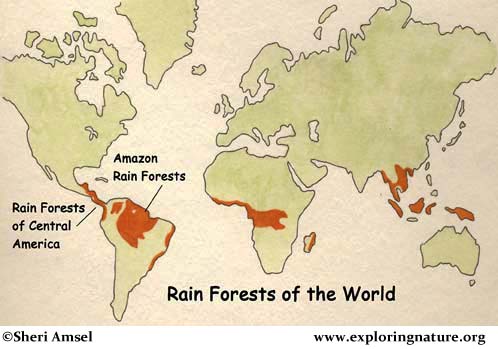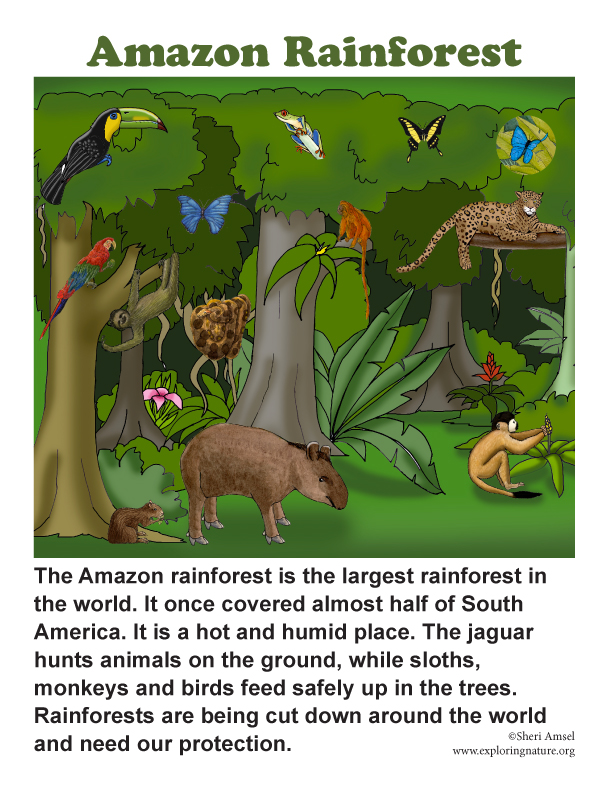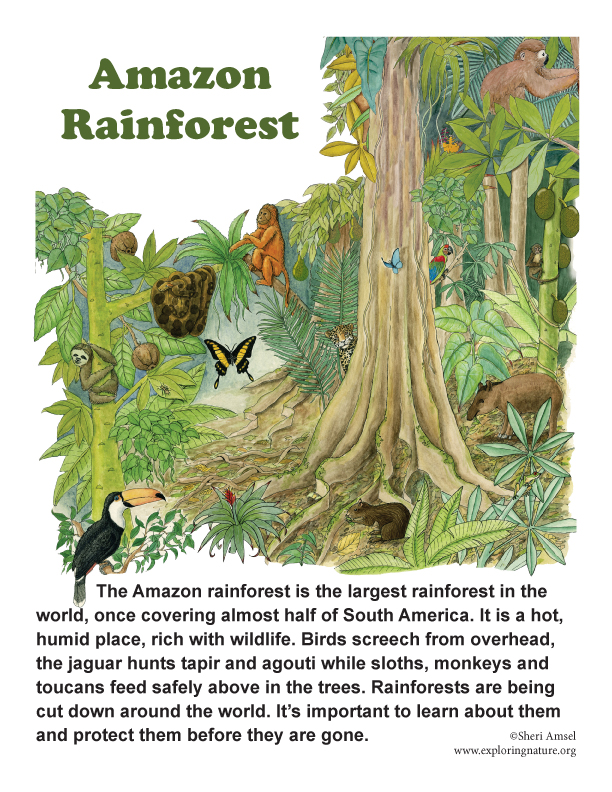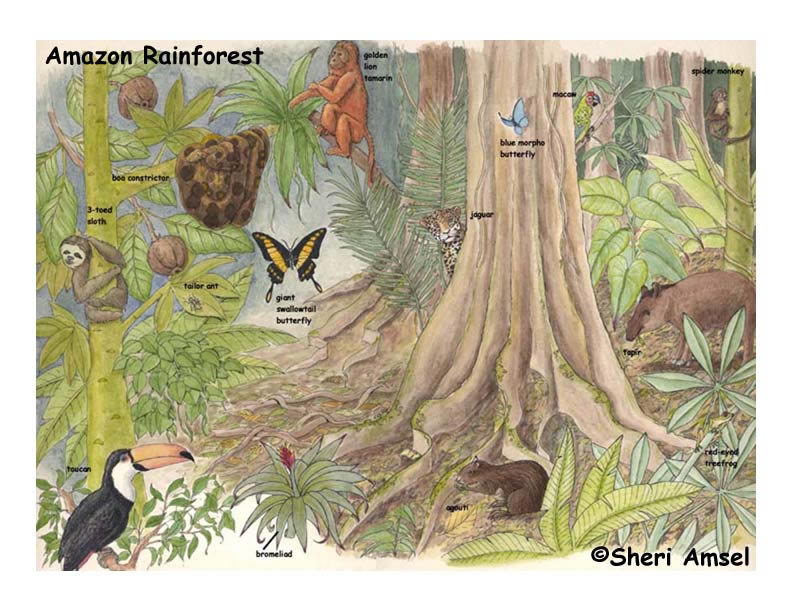

The rainforests of South America -- The Amazon rainforest is the largest rainforest in the world, once covering almost half the South American continent. It once stretched across Brazil, Colombia, Venezuela, Guyana, Ecuador, Peru, Bolivia and Suriname.
The Amazon rainforest is being cut down daily and has shrunk to a fraction of its original size. The rapid rate at which it is disappearing makes an accurate range impossible to record.
The Amazon is a wild and busy place. The air clings like a cloud, hot and moist. The smell is thick with rotting leaves and strong, sweet flower scents. Birds screech from overhead. Hidden animals scurry beneath the foliage causing leaves to rustle, as they search among the trees for food. Insects buzz and hum, and ants march in armies. This is the rainforest.
In the Amazon rainforest of Brazil, a golden lion tamarin scoops insects and other small animals out of a bromeliad for its dinner. A three-toed sloth slowly munches green leaves. Its fur grows a green moss in the wet air. That helps to hide it from hungry meat eaters. It is a lucky thing, for just above the trees a giant harpy eagle soars and looks for an animal to catch with its sharp claws. The trees are filled with sound and color -- a noisy scarlet macaw , a toucan or a spider monkey. On the forest floor, the agouti feeds on an avocado dropped from above. When it's finished, the leftover seed may take root in the rotting leaves, if there is enough light. A tapir nibbles at leaves. Off in the bush a hunting jaguar, one of the biggest predators in the Amazon, sniff the air for the scent of prey. Any animals caught unaware on the forest floor can become a meal for the hungry cat. A butterfly searches for blossoms, and a red-eyed tree frog waits for insects. The rain forest feeds them all. Smaller animals are busy in the forest too. Hummingbirds hover at giant blossoms to feed on nectar. While they collect, they carry pollen to another blossom, fertilizing the flowers as they go. Wasps, bees and bats also pollinate flowers as they collect nectar and pollen. Ants are everywhere. Busily carrying leaves or scraps of food back to their homes, they make a marching line for miles. As small as they are, they can be a fierce forest insect. They can have a painful bite or sting. There are many butterflies in the Amazon rain forest. The brilliant blue morpho butterfly glistens in the soft light. Owl butterflies search for ripened fruit. Painted ladies, monarchs, and heliconid butterflies feed on flower nectar and flash their bright colors throughout the forest.
Plants, like everything else in the rainforest, grow to giant sizes. The kapok tree can grow 150 feet high and have a huge branching trunk at the bottom called, a buttress to balance it in the shallow rain forest soil. In these buttresses, animals like boa constrictors find a safe place to hide. The monkey nut tree grows large cannonball fruits. The milk tree, when cut, spills out white drinkable sap. Brazil nut, mahogany, rubber, palm and mimosa trees, as well as giant ferns, fill out the forest. Vines called lianas wrap around the tree trunks, leaving long hanging tails through the forest. Strangler figs take over trees by rooting in their very bark. Bromeliads, maidenhair ferns, and many colorful orchids root in the crotches of branches where leaves and soil collect.
_____________________________________________________________________________________________________________
Related Activity:
Amazon Rainforest Coloring Page
Amazon Rainforest Hidden Picture
Amazon Rainforest Hidden Picture 2
Rainforest (General) Word Search
Amazon Rainforest Works Search (Adults)
Draw an Amazon Rainforest
Amazon Rainforest Diorama
Amazon Rainforest Mural Making Activity
Related Testing and Assessment:
Amazon Rainforest Labeling Page
Amazon Rainforest Read and React Quiz
Related Visual Aid:
Download Hi-Res In-Habitat Poster
_____________________________________________________________________________________________________________
When you research information you must cite the reference. Citing for websites is different from citing from books, magazines and periodicals. The style of citing shown here is from the MLA Style Citations (Modern Language Association).
When citing a WEBSITE the general format is as follows.
Author Last Name, First Name(s). "Title: Subtitle of Part of Web Page, if appropriate." Title: Subtitle: Section of Page if appropriate. Sponsoring/Publishing Agency, If Given. Additional significant descriptive information. Date of Electronic Publication or other Date, such as Last Updated. Day Month Year of access < URL >.
Amsel, Sheri. "Amazon Rainforest of South America" Exploring Nature Educational Resource ©2005-2024. December 13, 2024
< http://www.exploringnature.org/db/view/1741 >



